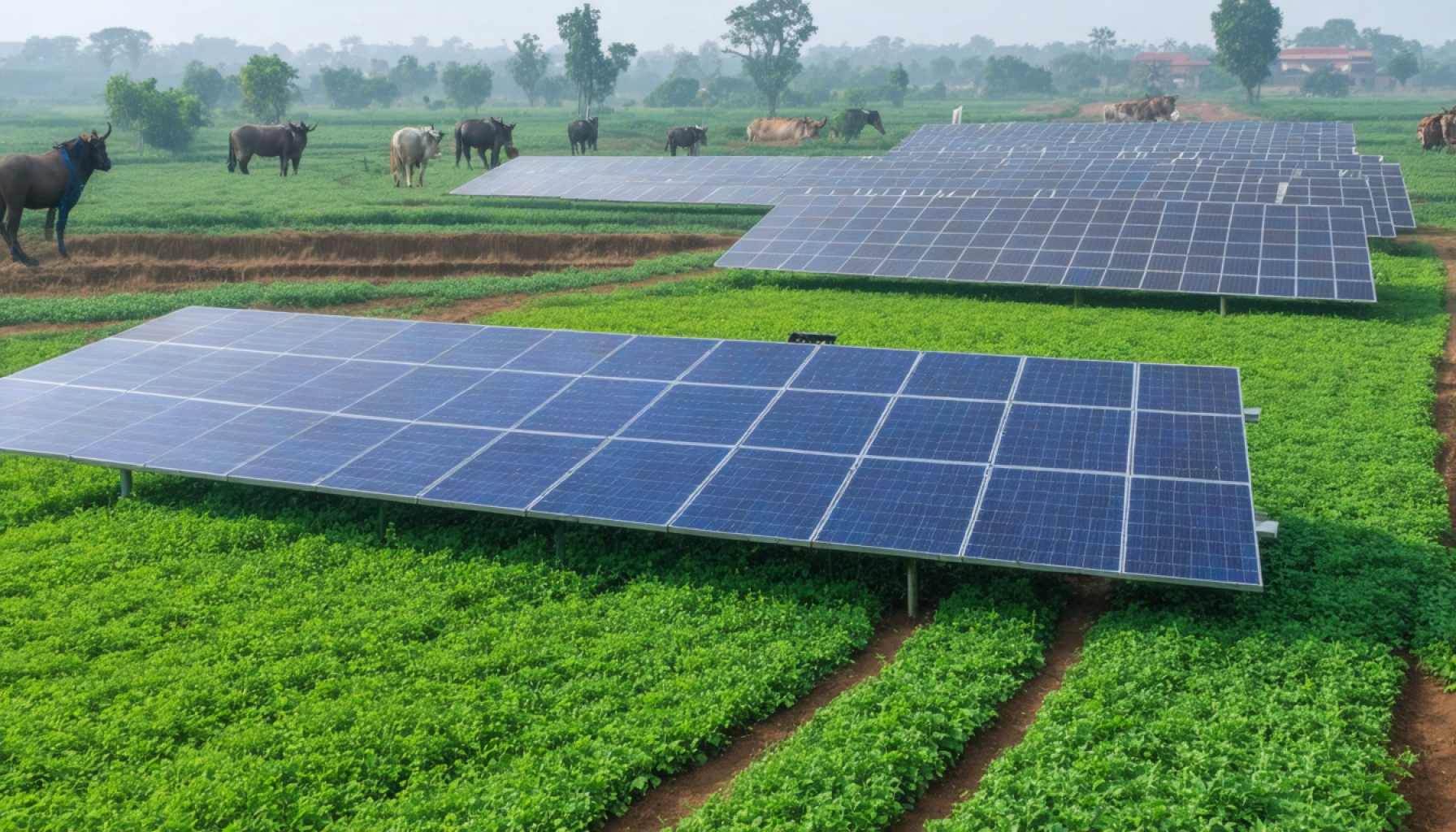- NTPC plans a significant investment of over 2 trillion rupees in renewable energy projects in Madhya Pradesh.
- The state will feature extensive solar and wind energy developments, including an impressive 20-gigawatt venture.
- NTPC’s projects will harness solar, wind, and hydro energy, emphasizing carbon-neutral solutions.
- The Adani Group proposes competing investments, focusing on hydroelectric storage and smart city development.
- Madhya Pradesh is emerging as a key player in India’s renewable energy landscape, symbolizing the shift to sustainable energy.
https://youtube.com/watch?v=5E0bYQPbVrs
In the heart of India’s vibrant landscape, Madhya Pradesh stands poised for a transformative leap into the future of renewable energy. NTPC, a powerhouse in the Indian energy sector, declared its ambitious intent to pour over 2 trillion rupees—approximately $23 billion—into a wave of renewable ventures across the state. This monumental investment echoes India’s clarion call to pivot away from traditional fossil fuels toward a sustainable energy future.
The state’s vast expanses will soon be dotted with gleaming solar panels and towering wind turbines, as NTPC, alongside its subsidiary NTPC Green Energy, crafts a sprawling network of sustainable energy projects. Each project is set to harvest the sun and wind, tap into the power of pumped hydro, and explore other innovative carbon-neutral solutions. Notably, the star of these ventures is a colossal 20-gigawatt project, promising to redefine energy landscapes for generations to come.
Meanwhile, the Adani Group, another titan in the industry, outlines its own vision for Madhya Pradesh with investments to rival NTPC. The group’s ambitious plans include hydroelectric storage, cutting-edge smart meters, and even the birth of a smart city rising from the state’s fertile grounds. Conversations about constructing an airport and exploring coal gasification only add more color to this canvas of possibilities.
Amid this flurry of innovation, Madhya Pradesh isn’t just catching up with a global trend; it’s setting a benchmark. The state is swiftly becoming a pulsating hub of green energy, a beacon of hope and progress as India steps boldly into an electrified and sustainable future.
Madhya Pradesh’s Leap into Renewable Energy: What You Need to Know
How-To Steps & Life Hacks: Transitioning to Renewable Energy
1. Initial Assessment: Before investing in renewable energy, assess the local environment and resources. Consider solar irradiation levels, wind speeds, and hydroelectric potential. Use tools like the Global Solar Atlas or Wind Resource Maps for detailed insights.
2. Feasibility Study: Conduct a feasibility study to evaluate the technical and financial viability of the project. Include analysis on local infrastructure, grid connectivity, and potential environmental impact.
3. Financial Planning: For individual or small-scale projects, explore financing options including grants, subsidies, or green loans.
4. Partner with Experts: Engage with experts in solar and wind technologies to optimize installations. Companies like NTPC Green Energy often provide comprehensive consultancy services.
Real-World Use Cases:
– Community-Owned Energy Projects: Leverage community investment to fund small to medium-sized solar farms, allowing residents to buy shares and benefit from savings on energy costs.
– Rural Electrification: Solar power can electrify remote villages, reducing reliance on diesel generators and extending reliable power to areas without grid connectivity.
Market Forecasts & Industry Trends:
– Global Shift: The International Energy Agency projects that renewables will account for almost 95% of the increase in global power capacity through 2026. Solar power will make up more than half of this growth.
– India’s Renewable Energy Target: India aims to achieve 450 GW of renewable energy capacity by 2030, demonstrating a strong commitment to transitioning towards renewable sources.
Reviews & Comparisons:
– NTPC vs. Adani Group:
– NTPC: Strong focus on solar and wind energy, with large-scale projects and subsidiary support (NTPC Green Energy).
– Adani Group: Diversified approach including hydroelectric, smart cities, and advanced technology integration.
Controversies & Limitations:
– Land Use: The development of large solar and wind farms can lead to land use conflicts, especially in agricultural regions.
– Intermittency Challenge: Renewables such as solar and wind are inherently intermittent, necessitating reliable storage solutions or supplementary power sources like hydroelectric or battery storage.
Features, Specs & Pricing:
– Solar Panels: Common types include monocrystalline, polycrystalline, and thin-film panels. Prices vary, with monocrystalline generally being more efficient but pricier.
– Wind Turbines: Range from small 400-watt turbines for home use to much larger 3 MW+ turbines for industrial applications.
Security & Sustainability:
– Data Security: Smart grids and meters increase efficiency but must implement robust cybersecurity measures to prevent hacking and data breaches.
– Environmental Impact: While renewable energy is cleaner, wind and solar farms can impact local ecosystems and wildlife if not planned sustainably.
Pros & Cons Overview:
– Pros:
– Reduces carbon footprint
– Lowers energy costs in the long run
– Generates jobs and boosts local economy
– Cons:
– High initial investment
– Requires significant land area
– Intermittency issues
Insights & Predictions:
– Evolving Technology: Advances in battery storage and smart grid technology will address intermittency challenges, making renewable energy more reliable.
– Economic Boost: Renewables will drive job creation, from construction and installation to maintenance and operation.
Actionable Recommendations:
– Personal Solar Investment: Consider rooftop solar to reduce energy costs.
– Community Engagement: Get involved in local renewable energy initiatives or cooperatives.
– Policy Advocacy: Advocate for supportive policies and incentives for renewable energy initiatives in your locality.
For more information, consider visiting the NTPC at NTPC or explore broader energy trends at International Energy Agency (IEA).
